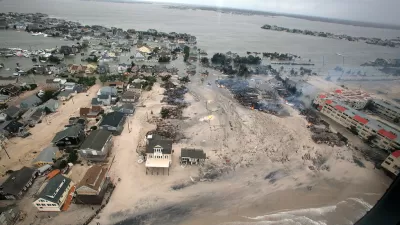After Hurricane Sandy, hundreds of architects and engineers offered their services to assist an overwhelmed NYC Department of Buildings in assessing storm-damaged properties. So why were they turned away?
Matt Chaban examines how New York's lack of Good Samaritan laws, and fears of lawsuits, prevented hundreds of willing architects and engineers from helping in post-Sandy building evaluations.
"For more than a decade now, following a spate of lawsuits stemming from work they did at Ground Zero and got sued for subsequently, architects, engineers and contractors have been pushing for their own Good Samaritan protections in Albany," notes Chaban. "With Sandy as their rallying cry, they are making a renewed push, arguing that having such protections in place would help the city be better prepared for the next disaster."
"What building professionals in New York want is the sort of protection their colleagues in 24 states already have. Many of those states, including California, Colorado, Florida and Louisiana, are places better accustomed to natural disasters that only now, courtesy of rising sea levels, seem to be increasingly in the cards for New York as well."
"Staten Island Assemblyman Michael Cusick, a co-sponsor of the Good Samaritan bill, said that with the growing instances of disaster, the need for the bill is obvious: 'We saw the need for architects and engineers and professionals in times of disaster. We want to have them feel comfortable to help in a time of need.'"
"Mr. Morgan gave the bill only a 50-50 chance of passage. But he believes that unified support from architects, engineers and contractors, who do not always work together on legislation, could help."
FULL STORY: Fears of lawsuits hold back Sandy help

Manufactured Crisis: Losing the Nation’s Largest Source of Unsubsidized Affordable Housing
Manufactured housing communities have long been an affordable housing option for millions of people living in the U.S., but that affordability is disappearing rapidly. How did we get here?

Americans May Be Stuck — But Why?
Americans are moving a lot less than they once did, and that is a problem. While Yoni Applebaum, in his highly-publicized article Stuck, gets the reasons badly wrong, it's still important to ask: why are we moving so much less than before?

Using Old Oil and Gas Wells for Green Energy Storage
Penn State researchers have found that repurposing abandoned oil and gas wells for geothermal-assisted compressed-air energy storage can boost efficiency, reduce environmental risks, and support clean energy and job transitions.

Minneapolis Bans Rent-Setting Software
Four cities have enacted restrictions on algorithmic software that can inflate rent costs.

Oakland to Add 244 New EV Chargers
Oakland plans to launch its new charging network at eight locations by the end of 2025.

Jane Goodall Inspires with Message of Hope, Resilience, and Environmental Action
Speaking in Pasadena, Jane Goodall offered a hopeful and inspirational message, urging global compassion, environmental responsibility, and the power of individual action to shape a better future.
Urban Design for Planners 1: Software Tools
This six-course series explores essential urban design concepts using open source software and equips planners with the tools they need to participate fully in the urban design process.
Planning for Universal Design
Learn the tools for implementing Universal Design in planning regulations.
Heyer Gruel & Associates PA
City of Moreno Valley
Institute for Housing and Urban Development Studies (IHS)
City of Grandview
Harvard GSD Executive Education
Salt Lake City
NYU Wagner Graduate School of Public Service
City of Cambridge, Maryland



























